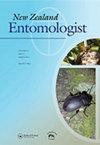2010年至2019年在澳大利亚悉尼建立的Dacinae亚科外来果蝇(昆虫纲,直翅目,地蝇科)的监测和对Dacinae的审查
IF 0.4
4区 农林科学
Q4 ENTOMOLOGY
引用次数: 1
摘要
摘要:由于国际货运和邮政的数量,悉尼的植物生物安全风险很高。此外,大量游客通过悉尼进入澳大利亚。1995年,建立了一系列果蝇监测陷阱,以监测外来果蝇的入侵。在这里,回顾了2010年至2019年间果蝇亚科(昆虫纲、双翅目、甲蝇科)的检测数量。结果显示,在此期间没有发现外来果蝇。然而,许多已确定的物种被检测到,现有物种被纳入国际标准。Bactrocera tryoni、B.cacuminatra、Dacus absoniphase和D.aequalis由于捕获了大量标本而被归类为已建立。在某些年份,悉尼可能是新胡氏芽孢杆菌虫害流行率较低的地区,而在其他年份则没有虫害。班克罗夫提B.bancrofti、布鲁尼亚B.brunea、贾维斯B.jarvisi和马伊B.mayi的数量很少,根据国际标准,悉尼很可能被归类为没有这些物种。此外,诱捕记录表明,悉尼没有蝾螈,但已知该物种发生在新南威尔士州内陆。苔藓虫Bactrocera broniae和B.endiandrae很可能是大多数年份都没有建立的入侵。本文章由计算机程序翻译,如有差异,请以英文原文为准。
Surveillance for exotic fruit fly of the subfamily Dacinae (Insecta, Diptera, Tephrididae) and a review of the Dacinae established in Sydney, Australia, between 2010 and 2019
ABSTRACT Sydney has a high plant biosecurity risk due to the volume of international freight and postal items. Additionally, a high number of tourists enter Australia through Sydney. In 1995, an array of fruit fly surveillance traps was established to monitor for exotic fruit fly incursions. Here, the number of detections of the fruit fly subfamily Dacinae (Insecta, Diptera, Tephrididae) was reviewed for the period between 2010 and 2019. The results revealed that no exotic fruit flies were detected during this period. However, many established species were detected and species present were placed into international standards. Bactrocera tryoni, B. cacuminatra, Dacus absonifacies, and D. aequalis were classified as established due to a large number of specimens trapped. Sydney was likely to be an area of low pest prevalence for B. neohumeralis in some years and pest free in other years. Low numbers of B. bancrofti, B. brunnea, B. jarvisi, and B. mayi were trapped, and Sydney was likely to be classified free from these species based on international standards. Also, trapping records indicated that Sydney was free from D. newmani however this species was known to occur in inland NSW. Bactrocera bryoniae and B. endiandrae were likely to be incursions that did not establish in most years.
求助全文
通过发布文献求助,成功后即可免费获取论文全文。
去求助
来源期刊

New Zealand Entomologist
ENTOMOLOGY-
CiteScore
0.70
自引率
33.30%
发文量
3
审稿时长
>12 weeks
期刊介绍:
The invertebrate diversity of New Zealand is of great interest worldwide because of its geographic isolation and geological history. The New Zealand Entomologist plays an important role in disseminating information on field-based, experimental, and theoretical research.
The New Zealand Entomologist publishes original research papers, review papers and short communications. We welcome submissions in all aspects of science regarding insects and arthropods in a New Zealand or Australasian setting. The journal’s subject matter encompasses taxonomy, phylogenetics, biogeography, biological control and pest management, conservation, ecology and natural history.
The journal is the official publication of the Entomological Society of New Zealand. Papers published or submitted elsewhere for publication will not be considered, but publication of an abstract or summary elsewhere (e.g. conference proceedings) does not preclude full publication in the New Zealand Entomologist. Accepted papers become copyright of the Entomological Society of New Zealand. The journal is published in English, but we also welcome publication of abstracts in Maori.
 求助内容:
求助内容: 应助结果提醒方式:
应助结果提醒方式:


